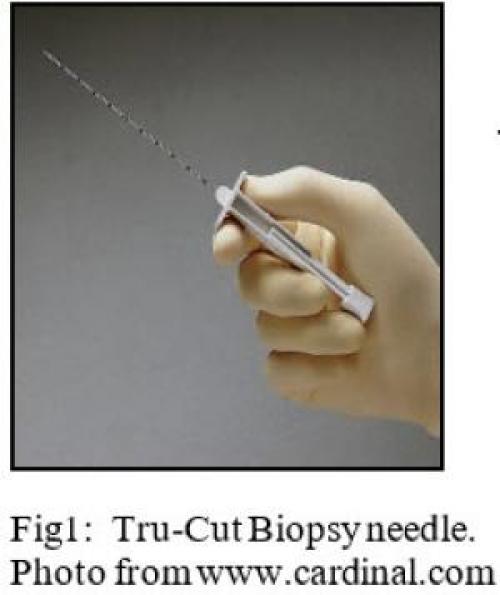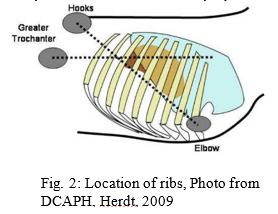Updated May 2018
Determining trace element status in cattle used to require large amounts of liver tissue – however, with the analytical equipment available now (ICP/MS), we are able to determine mineral concentrations, such as copper, on very small liver biopsy samples.
 |
It is more efficient and convenient to remove liver from cattle by means of a quick, non-invasive biopsy, rather than invasive procedures. Using a disposable biopsy needle, such as the Tru-Cut (Herdt, 2009) or Surecut (Littlewood et al., 1982) will yield enough liver sample for analysis (10 to 12 mg). For optimum copper analysis, we need 15 mg or 2 Tru-CUT samples. These biopsy needles are available through several distributors (e.g., VP 1770150). Ensure that you purchase needles that are at least 14 ga and 10-15 cm long (Herdt, 2009). The disposable biopsy needle has an outer cannula and inner, notched rod in which a tissue specimen is cut, trapped and withdrawn. |
For herd evaluation, at least 7 animals per feeding group should be tested. For optimal herd evaluation, these should not be animals with obvious signs of infectious or inflammatory disease. When samples from 10 or more animals are submitted, the price per sample can be reduced from the single-sample price (please contact the laboratory).
 Below are instructions on how to locate the insertion site, preparing the biopsy site, taking the samples and how to properly use the instrument. Although the biopsy needle is easy to use, it is important that the biopsy procedure is completed in the correct order.
Below are instructions on how to locate the insertion site, preparing the biopsy site, taking the samples and how to properly use the instrument. Although the biopsy needle is easy to use, it is important that the biopsy procedure is completed in the correct order.
Locating the insertion site:
Identify the right 10th intercostal space - Figure 2 illustrates the site to insert the liver biopsy needle. Note that the largest portion of the liver is beneath the lung, which leaves only a small portion of the liver accessible through the body wall.
Prepping the biopsy site:
Prepare as you would for surgery – infiltrate with 2-5 mL of 2% lidocaine solution under the skin and into the intercostal muscles. It is useful to use a scalpel blade and create a small stab incision through the skin in preparation for the biopsy needle.
Taking the sample:
Insert the needle as parallel to the ground as possible and angled slightly forward toward the left shoulder of the animal. Your needle will penetrate the skin, intercostal muscles and the diaphragm before entering the liver. This distance is only about 6 cm in most adult cows.
- Because you will be going through the diaphragm to get to the liver, you’ll notice a very distinct ‘popping’ sensation.
- Once through the diaphragm, you’ll notice that the needle moves with the respirations of the animals.
- Once the needle is in this position you will proceed with taking the biopsy.
Using the biopsy needle:
 |
Step 1: Figure 3. Insert the instrument into the animal with the “stylet” withdrawn into the needle, as shown below. The site, direction and depth of insertion are described above. |
 |
Step 2: Figure 4. Advance the stylet into liver tissue as needle is held stationary. Liver tissue fills the notch. |
Step 3: Figure 5. Advance the needle while holding the stylet stationary. It is critical not to pull the stylet back because there is no cutting surface on the stylet. The sharp edge of the needle point cuts the biopsy sample into the notch. |
 |
 |
Step 4: Figure 6. Advance the needle all the way over the stylet. This captures the sample and the instrument may be removed from the animal. |
For copper analysis of tissue at the AHL, we require 15 mg of liver tissue. If the notch is completely full, it usually contains 10-12 mg of liver sample; therefore 2 biopsy samples are needed. Using a hypodermic needle, remove the liver sample and transfer into a test tube. It is best not to use rubber-stoppered tubes as they have potential to leach trace elements and cause potential contamination. It is best to use test tubes that have plastic stoppers. If you require such vials, please contact the laboratory at ahl.supplies@uoguelph.ca [1] and we’ll gladly send you some.
Words of caution:
The liver biopsy procedure is very safe, and no complications have been observed in hundreds of samplings. However there is a small potential of inducing necrotic hepatitis, so if the animals have not been vaccinated against clostridial diseases, it is probably wise to administer an injection of penicillin or a similar antibiotic at the time of sampling.
Sending the sample to us:
The test tubes containing the sample should be sent to the laboratory using an overnight courier. Please do not add formalin, saline or anything else to the samples. Samples are to be slightly chilled over ice packs, or frozen. A ruminant submission form is required to be filled in and sent in with your sample(s).
Courier and submission form information:
If you are a veterinarian who practices within Ontario, we offer no-charge Purolator shipping. Please contact us at 519-824-4120 ext 54530 or ahl.supplies@uoguelph.ca [1] to order Purolator waybills for shipping to the Animal Health Laboratory.
Submission forms can be obtained online or contact us at 519-824-4120 ext 54530 and we’ll gladly fax or mail you customized submission forms.